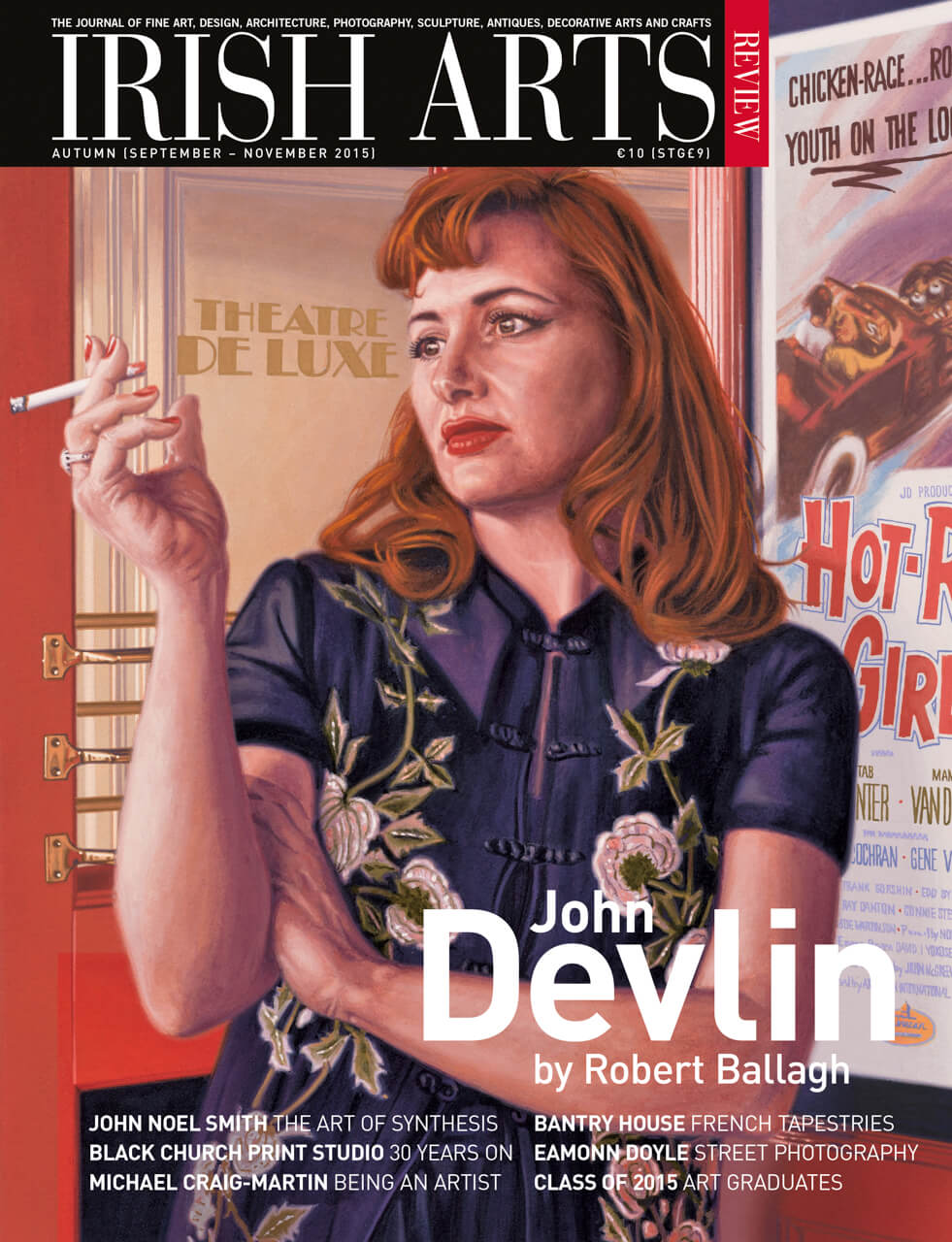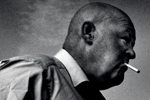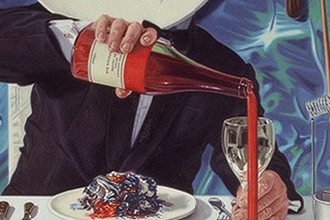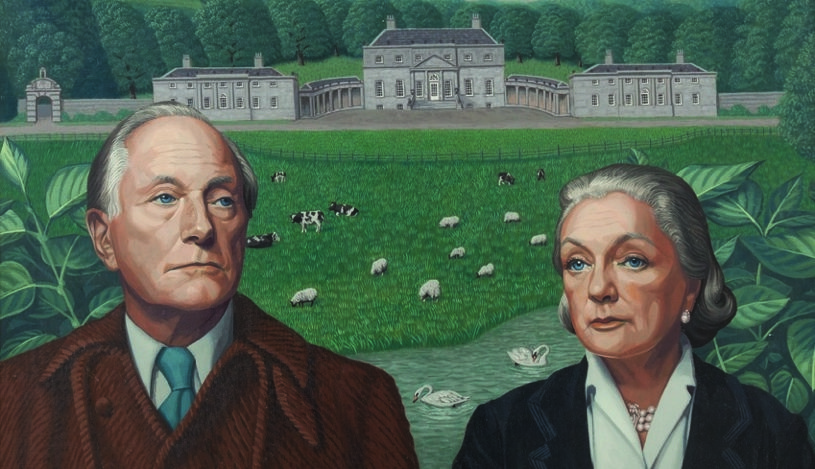
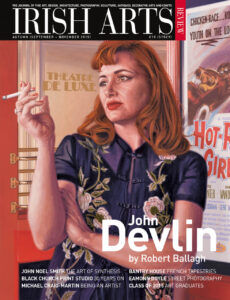
Peter Murray examines the career of Don Cronin, whose background in philosophy informs his sculpture.
Over the past two decades, Don Cronin has established himself as a sculptor of extraordinary confidence, technical accomplishment and artistic vision. A recent publication, Oblique Revisions: New Works by Don Cronin, a collaboration between Bonhams and the Cork-based Artistic Alliance, details recent works created by Cronin. The publication accompanied an exhibition held in June 2015, at Bonhams Gallery in Molesworth Street, Dublin. Polished, angular and highly finished, these recent works contrast with the more naturalistic bronze sculptures created by Cronin in the late 1990s, and represent a new level of accomplishment in a successful career.
The aesthetic origins of these recent works are complex, and lie in early Modernism; in particular Russian Constructivist and Suprematist art. The intense materiality of the metals used, with plates and bars of polished stainless steel contrasting with oxidized rusted iron, is evident. But this materiality contrasts with a lightness of touch; the forms frequently suggesting movement and flight. In Cronin’s art, the craft of welding and machining metal is invested with an aesthetic energy, through a sophisticated – and occasionally playful – juxtaposing of line, plane and mass. He then sometimes literally adds a twist, using considerable force and energy to contort those same materials into sculptures that, while retaining the marks of their making, are invested also with a sense of movement and of latent static energy. Evoking the aesthetic of Kazimir Malevich, who sought to bring art to a higher plane through combining materiality with the spiritual, these recent works echo also the angular spatiality of Tatlin and Rodchenko. Like these Russian artists of the early 20th century, Cronin references a world of machines and things, a man-made world, evoking ships, airplanes and cars, the high polished finish adding to the works’ seductive brilliance. Motorcycles are referenced in titles such as Bonneville, while Rotwang refers to the scientist in Fritz Lang’s 1927 film Metropolis.
There is a sense also in which Cronin carries forward the later 20th-century Modernist aesthetic of Anthony Caro and David Smith, an approach exemplified in the welded-steel sculptures of John Burke. Developing a personal language in abstract sculpture, Burke expressed a sense of the world as experienced by people, rather than a purely abstract geometric universe. This quality, which may be described as surprise, or alertness, is evident in Cronin’s art. Like Burke, in the process of making, Cronin assembles his recent works intuitively, working directly with materials, rather than from preliminary designs or drawings. Pico, a bronze sculpture, is abstract, but may also evoke a heron picking its way delicately through the water. A sense of the spiritual is hinted at in the title of Abelard, an angular leaning sculpture fabricated from stainless and Corten steel (Fig 4). The military fortification at Fort Camden provided an apt site for Trammelled, a tall diagonal sculpture suggesting an artillery gun set at its highest elevation. This frequent emphasis on the diagonal, on slanting lines, gives Cronin’s work a sense of movement and dynamism. There is also balance, where his sculptures can equally be read as ‘ascending’ and ‘descending’. In their poised equilibrium, they hover between sky and earth. Like the realization of a Constructivist drawing by Tatlin, Oxblood Scenario (Fig 2) hangs on a white wall, its bronze lines and plates aslant, linear contrasting with planar.
He acknowledges that his more recent work is less tactile than the earlier bronze sculptures, the polished smooth surfaces conveying less of the immediate presence of the artist
Born in Cork in 1969, Don Cronin initially took a foundation course in art at the Crawford College of Art, before switching to University College Cork, where he was awarded a Degree in Philosophy in 1991. He then returned to study sculpture at the Crawford College, graduating three years later. In 1995 his work was included in the ‘Cire Perdue’ exhibition at the Lavit Gallery and the following year he was artist in residence at the National Sculpture Factory. Since his graduation, Cronin has completed many public commissions, one of his earliest being a life-size bronze female figure, commissioned in 1995 by Michael Mortell, for UCC. This was followed by a semi-abstract Seeds I, II and III, produced for the foyer of the FÁS building on Rossa Avenue, a version of which was shown at the RHA in 1998. Around the same time, for Cork airport terminal building, he made Crows, representing a flock of birds, set against a wall of green veined marble. The theme of aviation is echoed in more recent commissions, such as Tumbling Helicopters, sited at St Colman’s school in Macroom. A celebration of Irish fauna, Cronin’s robust modelling of Crows is similar to his life-size bronze bull Big Sur, sited in Macroom and commissioned in 1997 by Cork County Council. While travelling in California in 1996, he had made a series of drawings and photographs of a bull at Big Sur. On returning to Ireland, he found that a local farmer had acquired a similar bull and so Cronin was able to continue his study of the massive beast. Progressing from drawings and photographs, to a series of quite rough wax maquettes – somewhat in the style of Degas’ bronze studies of horses – he eventually cast one of the maquettes in bronze. This small bronze bull won Cronin the commission. In discussing Big Sur, he emphasizes that while it is welcome that the work directly relates in its theme to the history of Macroom as an important market town, this should not used as the principal means of ‘reading’ the work of art.
Like many artists working on public art projects, Cronin invested time and effort in realizing works such as Big Sur, on a scale appropriate to the setting, in spite of working to a limited budget: ‘The work was modelled in plaster over a period of approximately two and a half months at the National Sculpture Factory. Moulds were made on site and these were delivered to Cast Foundry, in Dublin. The casting process took approximately four months and consumed 83% of the budget.’ However, the investment did bring a welcome return, in the form of an award some years later, through Dermot Desmond, of a commission to make a sculpture of a bull and bear for the Irish Financial Services Centre in Dublin. The artist is sanguine about the final appearance of Big Sur, and is pleased at the siting. ‘I have frequently been asked why the bull isn’t more dramatic in its pose, why it isn’t stomping the ground and ready to charge. The simple answer to this is that it is an Irish Bull. As often as not, this is a slow sullen animal, standing up to its oxters in mud in the pelting rain. I hope something of this is captured in the piece.’
Big Sur was sited in 1998 and the following year Cronin was commissioned by Cork County Council to make Folly, a public sculpture at Blarney (Fig 6). A circular tower constructed of rough uncut stones, Folly has four projecting stone corbels, representing the cardinal points of the compass. Surmounted by a stainless steel tree, stunted and windblown, the sculpture takes as its points of reference the natural and the built landscape of Co Cork. In nearby Waterloo, in the mid 19th century, local priest Fr Horgan built a replica of a medieval round tower. Folly, with its crowning tree, refers both to a capacity for endurance as well as to the natural history of the area. In 1999, Pendulum, a large stone and bronze sculpture (Fig 7), was commissioned by Tralee Urban District Council. A recent commission saw Cronin creating Gyrators, a three-metre-high stainless steel work, sited in Midleton in 2008, and also Schematic, a series of large bronze panels set into the facade of a new office and retail building in at the corner of Paul Street in Cork. Working with curator Richard Scott of Artistic Alliance, Cronin has also exhibited his work in the grounds of Mount Juliet House in Kilkenny and Ballymaloe House in Cork. His career has been sustained equally by percent for art public commissions, and by private collectors.
Over the years Cronin’s work has also evolved steadily, informed by both increasing skill in metal-working but also by an aesthetic sensibility informed by his studies in philosophy. He acknowledges that his more recent work is less tactile than the earlier bronze sculptures, the polished smooth surfaces conveying less of the immediate presence of the artist, but he revels in this relative freedom, to create works that stand in their own right, as works of art, rather than ‘representing’ aspects of the natural world and the human figure. In these recent works, the hand of the artist almost disappears, and the work is liberated, to convey in a more pure way, the language of sculpture.
Photography Figs 1-4 John Beasley. All images © The Artist.
Peter Murray is Director of the Crawford Art Gallery, Cork.
